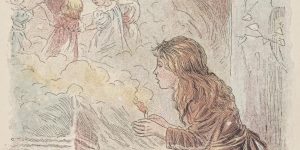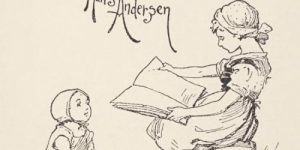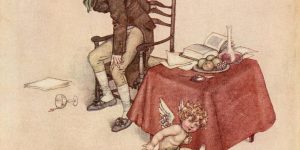The Snowdrop by Hans Christian Andersen
The Snowdrop Fairy Tale
by
Hans Christian Andersen
The Snowdrop
It was winter-time; the air was cold, the wind was sharp, but within the closed doors it was warm and comfortable, and within the closed door lay the flower; it lay in the bulb under the snow-covered earth.
One day rain fell. The drops penetrated through the snowy covering down into the earth, and touched the flower-bulb, and talked of the bright world above. Soon the Sunbeam pierced its way through the snow to the root, and within the root there was a stirring.
“Come in,” said the flower.
“I cannot,” said the Sunbeam. “I am not strong enough to unlock the door! When the summer comes I shall be strong!”
“When will it be summer?” asked the Flower, and she repeated this question each time a new sunbeam made its way down to her. But the summer was yet far distant. The snow still lay upon the ground, and there was a coat of ice on the water every night.
“What a long time it takes! what a long time it takes!” said the Flower. “I feel a stirring and striving within me; I must stretch myself, I must unlock the door, I must get out, and must nod a good morning to the summer, and what a happy time that will be!”
And the Flower stirred and stretched itself within the thin rind which the water had softened from without, and the snow and the earth had warmed, and the Sunbeam had knocked at; and it shot forth under the snow with a greenish-white blossom on a green stalk, with narrow thick leaves, which seemed to want to protect it. The snow was cold, but was pierced by the Sunbeam, therefore it was easy to get through it, and now the Sunbeam came with greater strength than before.
“Welcome, welcome!” sang and sounded every ray, and the Flower lifted itself up over the snow into the brighter world. The Sunbeams caressed and kissed it, so that it opened altogether, white as snow, and ornamented with green stripes. It bent its head in joy and humility.
“Beautiful Flower!” said the Sunbeams, “how graceful and delicate you are! You are the first, you are the only one! You are our love! You are the bell that rings out for summer, beautiful summer, over country and town. All the snow will melt; the cold winds will be driven away; we shall rule; all will become green, and then you will have companions, syringas, laburnums, and roses; but you are the first, so graceful, so delicate!”
That was a great pleasure. It seemed as if the air were singing and sounding, as if rays of light were piercing through the leaves and the stalks of the Flower. There it stood, so delicate and so easily broken, and yet so strong in its young beauty; it stood there in its white dress with the green stripes, and made a summer. But there was a long time yet to the summer-time. Clouds hid the sun, and bleak winds were blowing.
“You have come too early,” said Wind and Weather. “We have still the power, and you shall feel it, and give it up to us. You should have stayed quietly at home and not have run out to make a display of yourself. Your time is not come yet!”
It was a cutting cold! The days which now come brought not a single sunbeam. It was weather that might break such a little Flower in two with cold. But the Flower had more strength than she herself knew of. She was strong in joy and in faith in the summer, which would be sure to come, which had been announced by her deep longing and confirmed by the warm sunlight; and so she remained standing in confidence in the snow in her white garment, bending her head even while the snow-flakes fell thick and heavy, and the icy winds swept over her.
“You’ll break!” they said, “and fade, and fade! What did you want out here? Why did you let yourself be tempted? The Sunbeam only made game of you. Now you have what you deserve, you summer gauk.”
“Summer gauk!” she repeated in the cold morning hour.
“O summer gauk!” cried some children rejoicingly; “yonder stands one—how beautiful, how beautiful! The first one, the only one!”
These words did the Flower so much good, they seemed to her like warm sunbeams. In her joy the Flower did not even feel when it was broken off. It lay in a child’s hand, and was kissed by a child’s mouth, and carried into a warm room, and looked on by gentle eyes, and put into water. How strengthening, how invigorating! The Flower thought she had suddenly come upon the summer.
The daughter of the house, a beautiful little girl, was confirmed, and she had a friend who was confirmed, too. He was studying for an examination for an appointment. “He shall be my summer gauk,” she said; and she took the delicate Flower and laid it in a piece of scented paper, on which verses were written, beginning with summer gauk and ending with summer gauk. “My friend, be a winter gauk.” She had twitted him with the summer. Yes, all this was in the verses, and the paper was folded up like a letter, and the Flower was folded in the letter, too. It was dark around her, dark as in those days when she lay hidden in the bulb. The Flower went forth on her journey, and lay in the post-bag, and was pressed and crushed, which was not at all pleasant; but that soon came to an end.
The journey was over; the letter was opened, and read by the dear friend. How pleased he was! He kissed the letter, and it was laid, with its enclosure of verses, in a box, in which there were many beautiful verses, but all of them without flowers; she was the first, the only one, as the Sunbeams had called her; and it was a pleasant thing to think of that.
She had time enough, moreover, to think about it; she thought of it while the summer passed away, and the long winter went by, and the summer came again, before she appeared once more. But now the young man was not pleased at all. He took hold of the letter very roughly, and threw the verses away, so that the Flower fell on the ground. Flat and faded she certainly was, but why should she be thrown on the ground? Still, it was better to be here than in the fire, where the verses and the paper were being burnt to ashes. What had happened? What happens so often:—the Flower had made a gauk of him, that was a jest; the girl had made a fool of him, that was no jest, she had, during the summer, chosen another friend.
Next morning the sun shone in upon the little flattened Snowdrop, that looked as if it had been painted upon the floor. The servant girl, who was sweeping out the room, picked it up, and laid it in one of the books which were upon the table, in the belief that it must have fallen out while the room was being arranged. Again the flower lay among verses—printed verses—and they are better than written ones—at least, more money has been spent upon them.
And after this years went by. The book stood upon the book-shelf, and then it was taken up and somebody read out of it. It was a good book; verses and songs by the old Danish poet, Ambrosius Stub, which are well worth reading. The man who was now reading the book turned over a page.
“Why, there’s a flower!” he said; “a snowdrop, a summer gauk, a poet gauk! That flower must have been put in there with a meaning! Poor Ambrosius Stub! he was a summer fool too, a poet fool; he came too early, before his time, and therefore he had to taste the sharp winds, and wander about as a guest from one noble landed proprietor to another, like a flower in a glass of water, a flower in rhymed verses! Summer fool, winter fool, fun and folly—but the first, the only, the fresh young Danish poet of those days. Yes, thou shalt remain as a token in the book, thou little snowdrop: thou hast been put there with a meaning.”
And so the Snowdrop was put back into the book, and felt equally honored and pleased to know that it was a token in the glorious book of songs, and that he who was the first to sing and to write had been also a snowdrop, had been a summer gauk, and had been looked upon in the winter-time as a fool. The Flower understood this, in her way, as we interpret everything in our way.
That is the story of the Snowdrop.
The Snowdrop End




